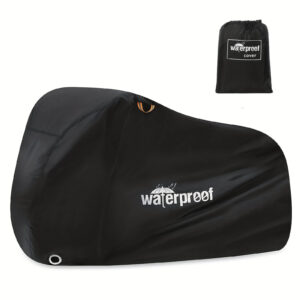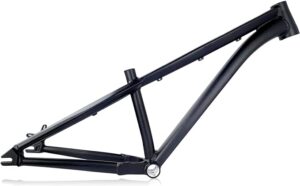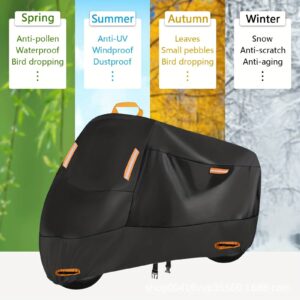Using and maintaining a waterproof bike cover correctly is essential for prolonging the life of your bicycle, especially if you store it outdoors where it’s exposed to the elements like rain, snow, and UV light. These environmental factors can damage your bike’s components, fade its paint, and significantly shorten its lifespan. However, with the right care and use of a waterproof bike cover, you can protect your bike effectively. Here’s a comprehensive guide on how to do just that.
Choosing the Right Waterproof Bike Cover
Material Matters: The durability and effectiveness of a bike cover largely depend on its material. Most bike covers are made from polyester, but the thickness of the polyester, measured in denier (D), varies. A higher denier count means a thicker, more durable, and weatherproof material. However, keep in mind that no material is completely waterproof if exposed to enough moisture, but thicker materials offer better resistance.
Size and Fit: Bike covers come in various sizes. Opting for a slightly larger cover than your bike’s size can make it easier to use and provide better coverage. A cover that fits too tightly might not extend all the way to the ground, leaving parts of your bike exposed to the elements.
Features to Look For:
Ventilation: To prevent condensation and moisture buildup inside the cover, which can lead to rust, look for covers with ventilation flaps or valves.
Tightening Mechanisms: A cover with a drawstring hem allows for a snug fit at the bottom, reducing the chances of moisture and dirt ingress and preventing the cover from being blown away by the wind.
Lock Holes: Ideally, lock holes should be positioned to secure both the frame and the wheel, providing an additional layer of security.
Seams: Double-stitched, heat-sealed seams offer enhanced tear and water resistance.
Using Your Waterproof Bike Cover
1.Covering Your Bike: When covering your bike, start from the top and work your way down, ensuring that the entire bike, including the wheels, is fully covered. The cover should touch the ground to prevent any exposure to the elements.
2.Securing the Cover: If your cover has lock holes, use them to secure your bike’s front wheel and, if possible, the frame to an immovable object. This not only protects your bike from theft but also keeps the cover in place. Tighten the drawstring hem to ensure a snug fit at the bottom.
3.Ventilation: Make sure the ventilation flaps or valves are positioned to allow air circulation, reducing the risk of condensation and moisture buildup inside the cover.
Maintaining Your Waterproof Bike Cover
Regular Checks: Periodically check your bike cover for any signs of wear and tear, especially around the seams and folds. Early detection of damage can prevent further deterioration.
Cleaning: Keep your bike cover clean by wiping it down with a damp cloth or washing it according to the manufacturer’s instructions. Avoid using harsh detergents that can degrade the waterproof coating.
Storage: When not in use, store your bike cover in a dry, cool place. If it comes with a storage bag, use it to protect the cover from dust and damage.
A waterproof bike cover is a simple yet effective way to protect your bike from the damaging effects of the weather. By choosing the right cover and following these guidelines for use and maintenance, you can ensure that your bike remains in good condition for years to come. Remember, investing a little time and effort in caring for your bike cover can save you a lot in bike repairs and replacements down the line.
PDF: How to Properly Use and Maintain a Waterproof Bike Cover







